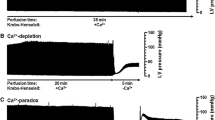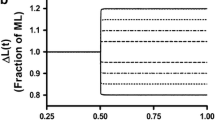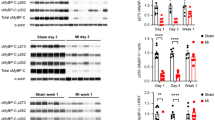Abstract
We investigated the effects of two purported calcium sensitizing agents, MCI-154 and DPI 201–106, and a known calcium sensitizer caffeine on Mg-ATPase (myofibrillar ATPase) and myosin ATPase activity of left ventricular myofibrils isolated from non-failing, idiopathic (IDCM) and ischemic cardiomyopathic (ISCM) human hearts (i.e. failing hearts). The myofibrillar ATPase activity of non-failing myofibrils was higher than that of diseased myofibrils. MCI-154 increased myofibrillar ATPase Ca2+ sensitivity in myofibrils from non-failing and failing human hearts. Effects of caffeine similarly increased Ca2+ sensitivity. Effects of DPI 201–106 were, however, different. Only at the 10−6 M concentration was a significant increase in myofibrillar ATPase calcium sensitivity seen in myofibrils from non-failing human hearts. In contrast, in myofibrils from failing hearts, DPI 201–106 caused a concentration-dependent increase in myofibrillar ATPase Ca2+ sensitivity. Myosin ATPase activity in failing myocardium was also decreased. In the presence of MCI-154, myosin ATPase activity increased by 11, 19, and 24% for non-failing, IDCM, and ISCM hearts, respectively. DPI 201–106 caused an increase in the enzymatic activity of less than 5% for all preparations, and caffeine induced an increase of 4, 11, and 10% in non-failing, IDCM and ISCM hearts, respectively. The mechanism of restoring the myofibrillar Ca2+ sensitivity and myosin enzymatic activity in diseased human hearts is most likely due to enhancement of the Ca2+ activation of the contractile apparatus induced by these agents. We propose that myosin light chain-related regulation may play a complementary role to the troponin-related regulation of myocardial contractility.
Similar content being viewed by others
References
Braunwald E, Bristow MR: Congestive heart failure: Fifty years of progress. Circulation 102: IV14-IV23, 2000
Warren SE, Kihara Y, Pesaturo J, Gwathmey JK, Phillips P, Morgan JP: Inotropic and lusitropic effects of MCI-154 (6-[4-(4′-pyridyl)-aminophenyl]-4,5-dihydro-3(2H)-pyridazinone) on human myocardium. J Mol Cell Cardiol 21: 1037-1045, 1989
Kitada Y, Morita M, Narimatsu A: Comparison of the effects of MCI-154, a new cardiotonic agent, and some Ca2+-sensitizing agents on the response of the contractile system to Ca2+ in skinned cardiac muscle. Japan J Pharmacol 50: 411-419, 1989
Perreault CL, Brozovich FV, Ransil BJ, Morgan JP: Effects of MCI-154 on Ca2+ activation of skinned human myocardium. Eur J Pharmacol 165: 305-308, 1989
Mori M, Takeuchi M, Takaoka H, Hata K, Hayashi Y, Yamakawa H, Yokoyama M: Oxygen-saving effect of a new cardiotonic agent, MCI-154, in diseased human hearts. J Am Coll Cardiol 29: 613-622, 1997
Hajjar RJ, Gwathmey JK, Briggs GM, Morgan JP: Differential effect of DPI 201-106 on the sensitivity of the myofilaments to Ca2+ in intact and skinned trabeculae from control and myopathic human hearts. J Clin Invest 82: 1578-1584, 1988
Gwathmey JK, Hajjar RJ: Relation between steady-state force and intracellular [Ca2+] in intact human myocardium: Index of myofibrillar responsiveness to Ca2+. Circulation 82: 1266-1278, 1990
Wendt IR, Stephenson DG: Effects of caffeine on Ca-activated force production in skinned cardiac and skeletal muscle fibres of the rat. Pflügers Arch 398: 210-216, 1983
Kitada Y, Narimatsu A, Matsumura N, Endo M: Increase in Ca2+ sensitivity of the contractile system by MCI-154, a novel cardiotonic agent, in chemically skinned fibers from the guinea pig papillary muscles. J Pharmacol Exp Ther 243: 633-638, 1987
Kitada Y, Narimatsu A, Matsumura N, Endo M: Contractile proteins: Possible targets for the cardiotonic action of MCI-154, a novel cardiotonic agent? Eur J Pharmacol 134: 229-231, 1987
Sellin LC, Alajoutsijarvi A, Tornquist K, Fraser M, Pippuri A, Ojala I: Inhibition of cardiac phosphodiesterase III by the novel cardiotonic agent 6-(4-(4′-pyridyl)aminophenyl)-4,5-dihydro3(2H)-pyridazinone hydrochloride. Arzneim-Forsch/Drug Res 38: 1787, 1988
Gwathmey JK, Slawsky MT, Briggs GM, Morgan JP: Role of intracellular sodium in the regulation of intracellular calcium and contractility. Effects of DPI 201-106 on excitation-contraction coupling in human ventricular myocardium. J Clin Invest 82: 1592-1605, 1988
Bohm M, Diet F, Kemkes B, Wankerl M, Erdmann E: Inotropic response to DPI 201-106 in the failing human heart. Br J Pharmacol 98: 275-283, 1989
Feldman M, Copelas L, Gwathmey JK, Phillips P, Warren S, Schoen F, Grossman W, Morgan JP: Deficient production of cyclic AMP: Pharmacologic evidence of an important cause of contractile dysfunction in patients with end-stage heart failure. Circulation 75: 331-339, 1987
Lee JA, Allen DG: Calcium sensitizers. Br Med J 300: 551-552, 1990
Solaro RJ, Pang DC, Briggs FN: The purification of cardiac myofibrils with Triton X-100. Biochim Biophys Acta 245: 259-262, 1971
Shiverick KT, Thomas LL, Alpert NR: Purification of cardiac myosin: Application to hypertrophied myocardium. Biochim Biophys Acta 393: 124-133, 1975
Smith PK, Krohn RI, Hermanson GT, Mallia AK, Gartner FH, Provenzano MD, Fujimoto EK, Goeke NM, Olson BJ, Klenk DC: Measurement of protein using bicinchoninic acid. Anal Biochem 150: 76-85, 1985
King EJ: Colorimetric determination of phosphorous. Biochem J 26: 292-297, 1932
Fabiato A: Computer programs for calculating total from specified free or free from specified total ionic concentrations in aqueous solutions containing multiple metals and ligands. Meth Enzymol 157: 378-417, 1988
Martin AF, Pagani ED, Solaro RJ: Thyroxine-induced redistribution of isoenzymes of rabbit ventricular myosin. Circ Res 50: 117-124, 1982
Pagani ED, Solaro RJ: Methods for measuring functional properties of sarcoplasmic reticulum and myofibrils in small samples of myocardium. Meth Pharmacol 5: 49-61, 1984
Huxley HE: The mechanism of muscular contraction. Science 164: 1356-1366, 1969
Ebashi S, Endo M, Ohtsuki I: Control of muscle contraction. Quart Rev Biophys 2: 351-384, 1969
Nakao K, Minobe W, Roden R, Bristow MR, Leinwand LA: Myosin heavy chain gene expression in human heart failure. J Clin Invest 100: 2362-2370, 1997
Lowes BD, Minobe W, Abraham WT, Rizeq MN, Bohlmeyer TJ, Quaife RA, Roden RL, Dutcher DL, Robertson AD, Voelkel NF, Badesch DB, Groves BM, Gilbert EM, Bristow MR: Changes in gene expression in the intact human heart. Downregulation of alpha-myosin heavy chain in hypertrophied, failing ventricular myocardium. J Clin Invest 100: 2315-2324, 1997
Mercadier JJ, Bouveret P, Gorza L, Schiaffino S, Clark WA, Zak R, Swynghedauw B, Schwartz K: Myosin isoenzymes in normal and hypertrophied human ventricular myocardium. Circ Res 53: 52-62, 1983
Schier JJ, Adelstein RS: Structural and enzymatic comparison of human cardiac muscle myosin isolated from infants, adults and patients with hypertrophic cardiomyopathy. J Clin Invest 69: 816-825, 1982
Miyata S, Minobe W, Bristow MR, Leinwand LA: Myosin heavy chain isoform expression in the failing and nonfailing human heart. Circ Res 86: 386-390, 2000
Pagani ED, Alousi AA, Grant AM, Older TM, Dziuban SW Jr, Allen PD: Changes in myofibrillar content and Mg-ATPase activity in ventricular tissues from patients with heart failure caused by coronary artery disease, cardiomyopathy, or mitral valve insufficiency. Circ Res 63: 380-385, 1988
Alpert NR, Gordon MS: Myofibrillar adenosine triphosphatase activity in congestive heart failure. Am J Physiol 202: 940-946, 1962
LeClercq JF, Swynghedauw B: Myofibrillar ATPase, DNA and hydroxyproline content of human hypertrophied heart. Eur J Clin Invest 6: 27-34, 1976
Peters TJ, Wells G, Oakley CM, Brooksby AB, Jenkins BS, Webb-People MM, Coltart DJ: Enzymic analysis of endomyocardial biopsy specimens from patients with cardiomyopathies. Br Heart J 39: 1333-1339, 1977
Alousi AA, Grant AM, Etzler JR, Cofer BR, Van der Bel-Kahn J, Melvin D: Reduced cardiac myofibrillar Mg-ATPase activity without change in myosin isozymes in patients with end-stage heart failure. Mol Cell Biochem 96: 79-88, 1990
Eisenberg E, Hill TL: Muscle contraction and free energy transduction in biological systems. Science 227: 999-1006, 1985
Stein LA, Schwarz RP Jr, Chock PB, Eisenberg E: Mechanism of actomyosin adenosine triphosphatase. Evidence that adenosine 5′-triphosphate hydrolysis can occur without dissociation of the actomyosin complex. Biochemistry 18: 3895-3909, 1979
Zot AS, Potter JD: Reciprocal coupling between troponin C and myosin cross-bridge attachment. Biochemistry 28: 6751-6756, 1989
Guth K, Potter JD: Effect of rigor and cycling cross-bridges on the structure of troponin C and on the Ca2+ affinity of the Ca2+-specific regulatory sites in skinned rabbit psoas fibers. J Biol Chem 262: 13627-13635, 1987
Hibberd MG, Trentham DR: Relationships between chemical and mechanical events during muscular contraction. Ann Rev Biophys Chem 15: 119-161, 1986
Kitada Y, Kobayashi M, Narimatsu A, Ohizumi Y: Potent stimulation of myofilament force and adenosine triphosphatase activity of canine cardiac muscle through a direct enhancement of troponin C Ca2+ binding by MCI-154, a novel cardiotonic agent. J Pharmacol Exp Ther 250: 272-277, 1989
Liao R, Gwathmey JK: Effects of a calcium sensitizer, MCI-154 on bovine cardiac troponin C. Biophys J 59: 585a, 1991
Teramura S, Yamakado T, Macda M, Nakano T: Effects of MCI-154, calcium sensitizer, on left ventricular systolic and diastolic function in pacing-induced heart failure in the dog. Circulation 95: 732-739, 1997
Gwathmey JK, Slawsky MT, Hajjar RJ, Briggs GM, Morgan JP: Role of intracellular calcium handing in force-interval relationships of human ventricular myocardium. J Clin Invest 85: 1599-1613, 1990
Beuckelmann DJ, Nabauer M, Erdmann E: Intracellular calcium handling in isolated ventricular myocytes from patients with terminal heart failure. Circulation 85: 1046-1055, 1992
Hajjar RJ, Schmidt U, Helm P, Gwathmey JK: Ca2+ sensitizers impair cardiac relaxation in failing human myocardium. J Pharmacol Exp Ther 280: 247-254, 1997
Scholtysik G, Salzmann R, Berthold R, Herzig JW, Quast U, Markstein R: DPI 201-106, a novel cardioactive agent. Combination of cAMP-independent positive inotropic, negative chronotropic, action potential prolonging and coronary dilatory properties. NaunynScluniedeberg'g Arch Pharmacol 329: 316-325, 1985
Henkel RD, VandeBerg JL, Shade RE, Leger JJ, Walsh RA: Cardiac beta heavy chain diversity in normal and chronically hypertensive baboons. J Clin Invest 83: 1487-1493, 1989
Swynghedauw B, Schwartz K, Leger JJ: Cardiac myosin phylogenic and pathological changes. Basic Res Cardiol 72: 254-160, 1977
Luchi RJ, Kritcher EM, Thyrum PT: Reduced cardiac myosin adenosine triphosphatase activity in dogs with spontaneously occurring heart failure. Circ Res 24: 513-519, 1969
Hajjar RJ, Gwathmey JK: Cross-bridge dynamics in human ventricular myocardium regulation of contractility in the failing hearts. Circulation 86: 1819-1826, 1992
Hasenfuss G, Mulieri LA, Leavitt BJ, Allen PD, Haeberle JR, Alpert NR: Alteration of contractile function and excitation-contraction coupling in dilated cardiomyopathy. Circ Res 70: 1225-1232, 1992
Okafor CC, Li X, Stepenek A, Hajjar RJ, Wood JR, Doye AA, Solaro RJ, Gwathmey JK: Ca2+-Activation: Relationship to contractile dysfunction in failing turkey myocardium. J Mol Cell Cardiol 2002 (submitted)
Clark WA Jr, Chizzonite RA, Everett AW, Rabinowitz M, Zak R: Species correlations between cardiac isomyosins. A comparison of electrophoretic and immunological properties. J Biol Chem 257: 5449-5454, 1982
Baudet S, Ventura-Clapier R: Differential effects of caffeine on skinned fibers from control and hypertrophied ferret hearts. Am J Physiol 259: 111803-111808, 1990
Lehman WH: Thick filament linked calcium regulation in vertebrate striated muscle. Nature 274: 80-81, 1978
Margossian SS, Bhan AK, Slayter HS: Role of the regulatory light chains in skeletal muscle actomyosin ATPase and in myofilament formation. J Biol Chem 258: 13359-13369, 1983
Tokunaga M, Suzuki M, Saeki K, Wakabayashi T: Position of the amino terminus of myosin light chain 1 and light chain 2 determined by electron microscopy with monoclonal antibody. J Mol Biol 194: 245-255, 1987
Packer M, Carver JR, Rodeheffer RJ, Ivanhoe RJ, DiBianco R, Zeldis SM, Hendrix GH, Bommer WJ, Elkaya U, Kukin ML, Mallis GI, Sollano JA, Shannon J, Tandon PK, DeMets DL: Effect of oral milrinone on mortality in severe chronic heart failure. N Engl J Med 325: 1468-1475, 1991
Hajjar RJ, Gwathmey JK: Calcium sensitizing inotropic agents in the treatment of heart failing: A critical review. Cardiovasc Drugs Ther 5: 961-966, 1991
Pagani ED, Alousi AA: New approaches for the treatment of failing myocardium: Myofibrillar proteins as potential targets for pharmacotherapy. In: R.E. Beamish, V. Panagia, N.S. Dhalla (eds). Pharmacological Aspects of Heart Disease. Martinus Nijhoff Publishing, Boston, 1986, pp 341-365
Pagani ED, Silver PJ: Physiological and pharmacological modulation of cardiac contractile proteins. Drug Dev Res 18: 279-293, 1989
Ming MJ, Hu D, Chen HS, Liu LM, Nan X, Hua CH, Lu RQ: Effect of MCI-154, a calcium sensitizer, on calcium sensitivity of myocardial fibers in endotoxic shock rats. Shock 14: 652-656, 2000
Author information
Authors and Affiliations
Rights and permissions
About this article
Cite this article
Okafor, C., Liao, R., Perreault-Micale, C. et al. Mg-ATPase and CA2+ activated myosin ATPase activity in ventricular myofibrils from non-failing and diseased human hearts – effects of calcium sensitizing agents MCI-154, DPI 201–106, and caffeine. Mol Cell Biochem 245, 77–89 (2003). https://doi.org/10.1023/A:1022813726734
Issue Date:
DOI: https://doi.org/10.1023/A:1022813726734




